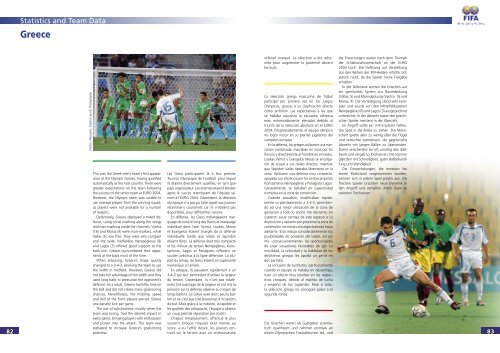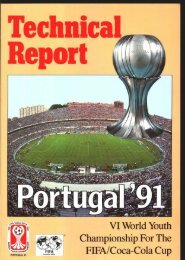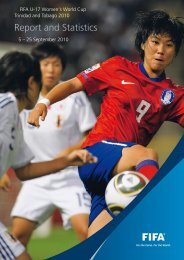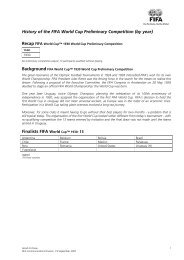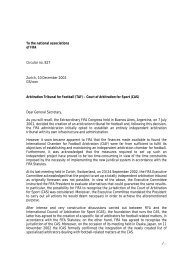You also want an ePaper? Increase the reach of your titles
YUMPU automatically turns print PDFs into web optimized ePapers that Google loves.
Statistics and Team Data<br />
Greece<br />
Photos: Mexsport, Sideline Sports Photography<br />
This was the Greek men’s team’s first appearance<br />
at the Olympic Games, having qualified<br />
automatically as the host country. There were<br />
greater expectations on the team following<br />
the success of the senior team at EURO <strong>2004</strong>.<br />
However, the Olympic team was unable to<br />
use overage players from the winning squad,<br />
as players were not available for a number<br />
of reasons.<br />
Defensively, Greece deployed a mixed defence,<br />
using zonal marking along the wings<br />
and man-marking inside the channels. Vyntra<br />
(16) and Moras (4) were man-markers, while<br />
Vallas (5) was free. They were very <strong>com</strong>pact<br />
and the wide midfielders Nempegleras (8)<br />
and Lagos (3) offered good support to the<br />
back line. Greece outnumbered their opponents<br />
at the back most of the time.<br />
When attacking, Greece’s shape quickly<br />
changed to a 3-4-3, allowing the team to use<br />
the width in midfield. However, Greece did<br />
not take full advantage of this width and they<br />
used long balls to pressurise the opponent’s<br />
defence. As a result, Greece had little time on<br />
the ball and did not create many goalscoring<br />
chances. Nevertheless, the mobility, speed<br />
and skill of the front players earned Greece<br />
one penalty kick per game.<br />
The use of substitutions, mostly when the<br />
team was losing, had the desired impact in<br />
every game, bringing players with enthusiasm<br />
and power into the attack. The team was<br />
reshaped to increase Greece’s goalscoring<br />
potential.<br />
Les Grecs participaient là à leur premier<br />
Tournoi Olympique de Football, pour lequel<br />
ils étaient directement qualifiés, en tant que<br />
pays organisateur. Les attentes étaient élevées<br />
après le succès retentissant de l’équipe seniors<br />
à l’EURO <strong>2004</strong>. Cependant, la sélection<br />
olympique n’a pas pu faire appel aux joueurs<br />
récemment couronnés car ils n’étaient pas<br />
disponibles, pour différentes raisons.<br />
En défense, les Grecs mélangeaient marquage<br />
de zone le long des flancs et marquage<br />
individuel dans l’axe. Vyntra, Loukas, Moras<br />
et Evangelos étaient chargés de la défense<br />
individuelle tandis que Vallas et Spyridon<br />
étaient libres. La défense était très <strong>com</strong>pacte<br />
et les milieux de terrain Nempegleras, Konstantinos,<br />
Lagos et Panagiotis offraient un<br />
soutien précieux à la ligne défensive. La plupart<br />
du temps, les Grecs étaient en supériorité<br />
numérique à l’arrière.<br />
En attaque, ils passaient rapidement à un<br />
3-4-3 qui leur permettait d’utiliser la largeur<br />
du terrain. Cependant, ils n’ont pas totalement<br />
tiré avantage de la largeur et ont mis la<br />
pression sur la défense adverse au moyen de<br />
longs ballons. La Grèce avait donc peu le ballon<br />
et ne s’est pas créé beaucoup d’occasions<br />
de but. Mais grâce à la mobilité, la rapidité et<br />
les qualités des attaquants, l’équipe a obtenu<br />
un coup pied de réparation par match.<br />
Chaque remplacement, effectué le plus<br />
souvent lorsque l’équipe était menée au<br />
score, a eu l’effet désiré, les joueurs rentrant<br />
sur le terrain avec un enthousiasme<br />
offensif marqué. La sélection a été reformée<br />
pour augmenter le potentiel devant<br />
les buts.<br />
La selección griega masculina de fútbol<br />
participó por primera vez en los Juegos<br />
Olímpicos, gracias a su clasificación directa<br />
<strong>com</strong>o anfitrión. Las expectativas a las que<br />
se hallaba expuesta la escuadra olímpica<br />
eran extremadamente elevadas debido al<br />
triunfo de la selección absoluta en el EURO<br />
<strong>2004</strong>. Desgraciadamente, el equipo olímpico<br />
no logró incluir en su plantel jugadores del<br />
campéon europeo.<br />
En la defensa, los griegos utilizaron una marcación<br />
<strong>com</strong>binada: marcaban en zona por los<br />
flancos y directamente al hombre en el medio.<br />
Loukas Vyntra y Evangelos Moras se encargaron<br />
de acosar a sus rivales directos, mientras<br />
que Spyridon Vallas operaba libremente en la<br />
zona. Aplicaron una defensa muy <strong>com</strong>pacta,<br />
apoyada con eficiencia por los centrocampistas<br />
Konstantinos Nempegleras y Panagiotis Lagos.<br />
Generalmente, se hallaban en superioridad<br />
numérica en la zona de contención.<br />
Cuando atacaban, modificaban rápidamente<br />
su planteamiento a 3-4-3, permitiendo<br />
así una mejor utilización de la zona de<br />
gestación a todo lo ancho. No obstante, no<br />
supieron sacar ventaja de este espacio a su<br />
disposición y optaron por presionar la zona de<br />
contención contraria con largos balones hacia<br />
adelante. Esto redujo considerablemente sus<br />
posibilidades de posesión del balón, así <strong>com</strong>o<br />
–consecuentemente– las oportunidades<br />
de crear situaciones favorables de gol. La<br />
movilidad, la velocidad y la habilidad de los<br />
delanteros griegos les aportó un penal en<br />
dos partidos.<br />
La inclusión de sustitutos, particularmente<br />
cuando el equipo se hallaba en desventaja,<br />
tuvo un efecto muy positivo en los respectivos<br />
choques, debido al espíritu de lucha<br />
y empeño de los suplentes. Pese a todo,<br />
la selección griega no consiguió pasar a la<br />
segunda ronda.<br />
Die Griechen waren als Gastgeber automatisch<br />
qualifiziert und nahmen erstmals an<br />
einem Olympischen Fussballturnier teil, und<br />
die Erwartungen waren nach dem Triumph<br />
der A-Nationalmannschaft an der EURO<br />
<strong>2004</strong> hoch. Die Hoffnung auf Verstärkung<br />
aus den Reihen der EM-Helden erfüllte sich<br />
jedoch nicht, da die Spieler keine Freigabe<br />
erhielten.<br />
In der Defensive setzten die Griechen auf<br />
ein gemischtes System aus Raumdeckung<br />
(Vallas, 5) und Manndeckung (Vyntra, 16 und<br />
Moras, 4). Die Verteidigung stand sehr kompakt<br />
und wurde von den Mittelfeldspielern<br />
Nempegleras (8) und Lagos (3) ausgezeichnet<br />
unterstützt. In der Abwehr waren die griechischen<br />
Spieler meistens in der Überzahl.<br />
Im Angriff sollte ein 3-4-3-System helfen,<br />
das Spiel in die Breite zu ziehen. Die Mannschaft<br />
spielte aber zu wenig über die Flügel<br />
und versuchte stattdessen, die gegnerische<br />
Abwehr mit langen Bällen zu überwinden.<br />
Damit verschenkte sie oft unnötig den Ballbesitz<br />
und vergab so Torchancen. Die Stürmer<br />
glänzten mit Schnelligkeit, guter Ballbehandlung<br />
und Wendigkeit.<br />
Die Einwechslungen, die meistens bei<br />
einem Rückstand vorgenommen wurden,<br />
wirkten sich in jedem Spiel positiv aus. Die<br />
frischen Spieler brachten neue Dynamik in<br />
den Angriff und verhalfen ihrem Team zu<br />
weiteren Torchancen.<br />
82 83


